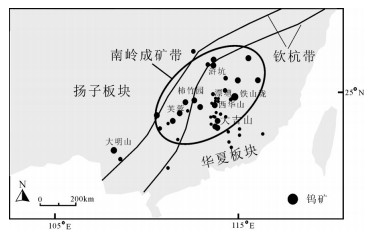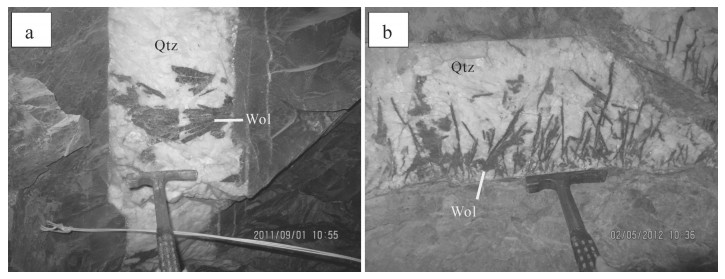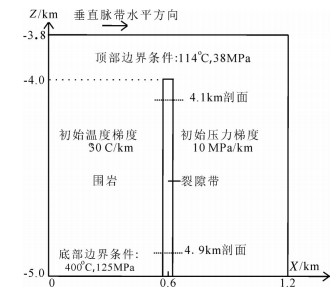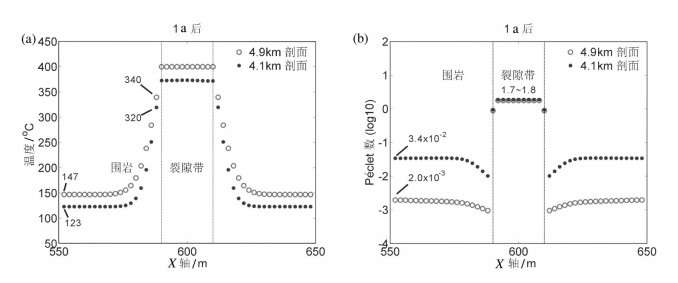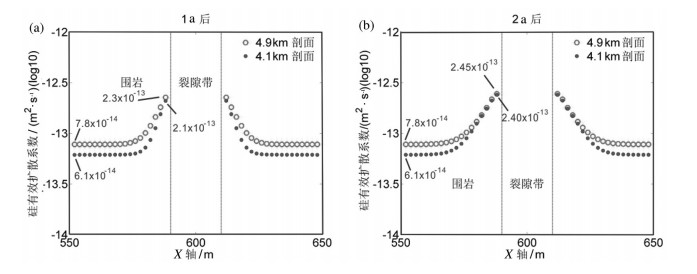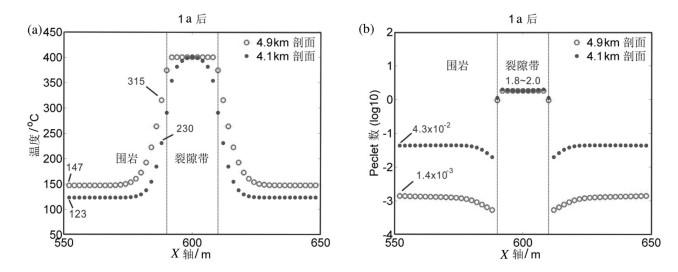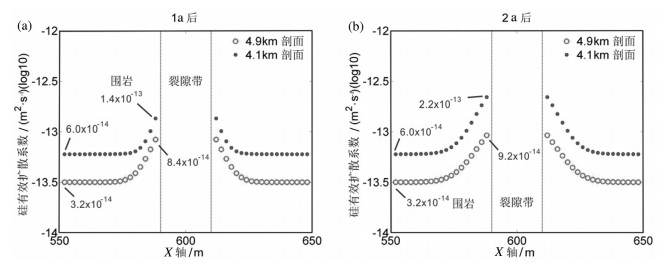The mechanisms for the formation of the alteration halos in tungsten deposits of Nanling Mountains, South China
-
摘要:
中国地质工作者在20世纪80年代已发现南岭地区许多石英脉型钨矿床的蚀变晕宽度随深度递减,然而这一蚀变特征的形成机制至今仍未得到较好的解释。通过模拟热液运移和硅从裂隙带向邻近围岩的扩散过程,发现流体温度和围岩孔隙度是影响石英脉型钨矿床蚀变特征的重要变量。高温和高孔隙度会加速硅从裂隙向邻近围岩扩散,从而形成较宽的蚀变。在围岩孔隙度均一分布的情况下,由于深部温度高于浅部,深部围岩蚀变宽于浅部蚀变。围岩孔隙度随深度递减会抵消温度对硅扩散速率的影响,使深部围岩形成较窄的蚀变。围岩孔隙度随深度递减可能是形成石英脉型钨矿床蚀变宽度随深度减小的有效机制。前人将钨矿蚀变特征归因于岩浆热液过渡性流体不均一的物理性质,该研究为这一科学问题提供新的解释。
Abstract:Geologists discovered in the 1980s that alteration halos decrease with increasing depth in many tungsten deposits of the Nanling Mountains. However, the mechanism for the formation of the alteration characteristics remains poorly understood. In this paper, the authors investigated hydrothermal flow and silica diffusion from fractures to adjacent wallrock at these tungsten deposits by using finite element based numerical experiments. The authors have found that fluid temperature and wallrock porosity exert a strong influence on silica diffusion from fractures to adjacent wallrock. Both high temperature and high porosity favor silica diffusion from fractures to adjacent wallrock and form wide alteration halos. Constant-porosity wallrock forms wider alteration halos at deeper levels, which is inconsistent with alteration characteristics of the tungsten deposits in the Nanling Mountains. Wallrock porosity that decreases with increasing depth forms alteration halos like those in those the tungsten deposits. The wall rock lithology and fracture distribution those tungsten deposits favor the formation of depth-dependent porosity and permeability. Evaluation of these two factors may help the exploration. Aqueous NaCl solutions were used in the numerical experiments. It is therefore concluded that inhomogeneous magmatic hydrothermal fluids are unnecessary in explaining the alteration characteristics at these tungsten deposits.
-
Keywords:
- tungsten deposits /
- alteration halos /
- fluid flow /
- porosity /
- diffusion coefficient /
- Nanling
-
湖南西北部花垣铅锌矿位于湘西-鄂西铅锌成矿带北部, 潜在储量逾1000×104 t[1-2]。自北而南分布李梅、耐子堡、大脑坡、渔塘、老虎冲等一系列矿床,铅锌品位约为3%, 矿种较单一, 是湖南西北部重要的矿产资源富集区。花垣铅锌矿矿集区的多个铅锌矿床为典型的MVT型铅锌矿床[3-4]。矿床的主要特征为铅锌矿石品位较低、富集规模巨大、易于采选,因此具有较高的经济开发效益。
根据前人研究成果,花垣铅锌矿矿集区内的多个铅锌矿床,其容矿岩层主要是清虚洞组中段厚层状藻灰岩[5],层理不发育,质纯性脆[6];受应力挤压时,容易形成各种裂隙,或小错动(断层),形成层状角砾岩,为成矿流体的运移和储集提供了有利的地质环境和成矿条件[7-8],进而形成了多种样式的脉状富矿体,矿石类型丰富多样但以角砾岩为主,有斑脉状、网脉状、细脉状、似层状等含矿角砾岩,还有少量浸染状矿石。而整合型的层状矿体,由于构造裂隙不发育,矿液主要顺原生岩层中的孔隙及少量裂隙运移,缺乏成矿空间,因此该类型矿体品位不高[9]。
前人在研究区建立了铅锌矿与岩相的关系[10],总结了铅锌矿与构造背景之间的关系[11],厘清了成矿物质来源[12]和矿化元素的富集规律[13],但是缺少对成矿区内不同成矿阶段角砾岩地质特征的研究,因此本文重点从地质判断标志和划分方法的角度开展角砾岩含矿性研究,为找矿地质标志提供佐证。
1. 区域地质背景
1.1 大地构造位置
湖南花垣铅锌矿矿集区位于湖南省湘西自治州吉首市花垣县境内(图 1)。花垣地区的大地构造位置在上扬子板块东南边缘,横跨上江南板块和上扬子板块,处于武陵山弱变形带中[14]。研究区在震旦纪—早古生代为扬子板块东南部的边缘斜坡构造带;在加里东末期,研究区西侧受华夏板块与扬子板块碰撞挤压产生的向西逆冲推覆构造运动的影响,发育一系列北东向的逆冲断裂和褶皱;到晚古生代,花垣地区受区域板块碰撞影响,成为局部隆起区域,部分地区可见浅水沉积。印支—燕山运动中, 区内主要为隆起-断陷状态[15]。
![]() 图 1 花垣矿集区地质矿产简图(据参考文献[5]修改)1—地层界线;2—断层及编号;3—铅锌矿床;Nh2bx—板溪群;Nh2d—大塘坡组;Nh2n—南沱组;Z—震旦系;−C1n-s—牛蹄塘组+石牌组;−C1s—下石牌组;−C1q—清虚洞组;−C2g/−C2a/−C2c—高台组/熬溪组/车夫组;−C2-3l—娄山关组;O—奥陶系;F1—张家界花垣断裂;F2—麻栗场断裂;F3—松桃水田断裂Figure 1. Simplified geological map of the Huayuan ore concentration area
图 1 花垣矿集区地质矿产简图(据参考文献[5]修改)1—地层界线;2—断层及编号;3—铅锌矿床;Nh2bx—板溪群;Nh2d—大塘坡组;Nh2n—南沱组;Z—震旦系;−C1n-s—牛蹄塘组+石牌组;−C1s—下石牌组;−C1q—清虚洞组;−C2g/−C2a/−C2c—高台组/熬溪组/车夫组;−C2-3l—娄山关组;O—奥陶系;F1—张家界花垣断裂;F2—麻栗场断裂;F3—松桃水田断裂Figure 1. Simplified geological map of the Huayuan ore concentration area1.2 主要地层
花垣铅锌矿矿集区的主要地层为沉积-浅变质特征的沉积岩地层。主要地层包括元古宇青白口系板溪群、南华系—三叠系,其中最发育的是寒武系海相地层。地层褶皱呈北北东—北东方向展布,受区域构造活动控制。区域内与铅锌矿成矿相关的地层为(图 2):①中—上寒武统娄山关组,主要岩性为层状白云岩,呈灰白色,岩性脆,节理发育,层厚在900~1700 m之间,主要分布在花垣县城西侧,以及张家界-花垣断裂的北部地区。②中寒武统高台组,主要岩性为泥质白云岩,呈灰黑色,岩石表面具深色风化面,节理发育,层厚在6~45 m之间,主要分布在花垣县城西南。③下寒武统清虚洞组,为区域内铅锌矿的主要含矿层位,按照地质年代和位置可分为上、中、下3段。上段主体岩性为层状白云岩,节理发育,可见“刀砍纹”,层厚在70~120 m之间;中段主体岩性为厚层状藻礁灰岩和碎屑灰岩,呈灰黑色,方解石脉大量发育,可分为顺层和切层2组,层厚在3~10 m之间;下段主体岩性为薄层状条带灰岩和豹皮状泥晶灰岩,呈灰黑色,层厚60~150 m之间。清虚洞组中段的层状藻灰岩相角砾岩为花垣铅锌矿矿集区的主要矿化层位,在花垣铅锌矿矿集区大面积出露,也是该区域内的主要找矿标志性地层。④下寒武统石牌组,主要岩性为薄层状泥质到粉砂质页岩,层厚160~200 m,主要分布在张家界-花垣大型断裂的南部区域。
1.3 矿石特征
花垣铅锌矿矿集区的主要矿物类型有闪锌矿、方铅矿和黄铁矿,其中闪锌矿所占比例为10%~30%,方铅矿为1%~10%,黄铁矿为1%~5%。脉石矿物主要为方解石和白云石,少量石英和重晶石。该矿集区具经济价值的矿化元素主要为Zn、Pb和S。
2. 层状角砾岩基本地质特征
角砾岩作为一种受构造因素影响强烈的岩石产物,除提供成矿流体的主要运移通道外,也是重要的储矿容矿空间。花垣地区的含矿角砾岩是成矿作用过程伴生构造运动的产物[16]。
花垣铅锌矿矿集区内的李梅矿床中,含角砾岩的地层广泛发育。按上文所述,研究区主要含矿地层是寒武纪清虚洞组中段。根据前人的研究成果,结合野外地质特征,笔者对花垣地区藻灰岩相层状角砾岩的分布特征和出露情况进行总结与分析。
2.1 层状角砾岩的地表分布特征
花垣铅锌矿矿集区内角砾岩出露广泛,以寒武纪清虚洞组中段的藻灰岩相层状角砾岩为主要成矿层位。层状角砾岩在花垣铅锌矿矿集区的出露位置以渔塘、李梅、大脑坡等矿区为主。以李梅矿区为例,角砾岩以层状为主,其他类型包括似层状,网脉状、浸染状等。角砾岩中角砾的大小、破碎程度、胶结物类型与存在方式,都影响角砾岩的特征和矿石的类型。角砾岩的分布特征和含矿性又直接对找矿工作有指导作用。
花垣铅锌矿矿集区李梅矿床中清虚洞组中段的藻灰岩相层状角砾岩分布特征明显受区域构造作用的影响,岩层由于构造运动产生的大量节理、裂隙、破碎断裂开和孔洞,为成矿流体提供运移通道和储矿空间。同时区域断裂和褶皱直接控制了含矿角砾岩的分布规律,主要含矿地层出露在断裂南侧。
2.2 层状角砾岩的垂向分布特征
花垣铅锌矿矿集区内区域构造主要由一组北北东向走滑正断裂、北东向逆冲断裂及平缓褶皱组成,与矿集区主要矿床的展布方向一致。通过野外实地勘查测量,矿区断裂构造发育,发育花垣-茶洞大断裂、麻栗场逆冲断裂;褶皱较平缓,主要有摩天岭复式背斜、李梅平缓背斜等(图 2)。
矿集区的铅锌富矿体受次级背斜和层内裂隙控制,显示富矿体赋存于层状角砾岩中,且大致顺岩层分布。找矿前景最好的赋矿部位以层状和似层状的角砾岩为主(图 2)。这两种含矿角砾岩中的铅锌金属量占总量的60%以上,为花垣铅锌矿矿集区中最重要的含矿岩石类型[17]。
由李梅矿床的垂向矿体剖面图(图 3)可知,层状和似层状角砾岩为主要的矿体赋存形态。矿体展布形态为明显的长条/带状,长度、宽度较大,同时厚度小,大致为北北东向展布。根据矿区资料显示最长矿体为1575 m,宽度最大为1100 m,层厚最高为17 m。李梅矿床的主要矿体赋存于清虚洞组中段近底部的地层中,储量超过1×104 t。
![]() 图 3 李梅矿区第9勘探线富矿体剖面图(据参考文献[6]修改)1—富矿体;2—矿化层/带;3—地层分界线;4—钻探工程及编号Figure 3. Geological section of ore shoot along No.9 exploration line in Limei ore district
图 3 李梅矿区第9勘探线富矿体剖面图(据参考文献[6]修改)1—富矿体;2—矿化层/带;3—地层分界线;4—钻探工程及编号Figure 3. Geological section of ore shoot along No.9 exploration line in Limei ore district3. 不同成矿阶段层状角砾岩的地质特征
角砾岩是沉积碎屑岩的一种,通过岩石中的角砾、胶结物及相互关系,可以判断母岩成分与性质、沉积过程中的构造运动强度、流体成矿过程和成矿阶段有关。研究区的构造角砾岩属于孔隙度较大的岩石类型,可为成矿流体提供运移通道,同时为矿物沉淀和结晶析出提供空间。花垣铅锌矿矿集区的含矿角砾岩是受构造运动破坏的破碎岩石与成矿流体共同作用的产物。
本次选取李梅矿区的藻灰岩相层状角砾岩开展研究,研究层状角砾岩主要成矿阶段岩石-矿物含矿的地质特征,为岩石、矿物、流体地球化学等分类提供支持。根据角砾与胶结物的关系,花垣铅锌矿层状角砾岩可以划分为3期:成矿前角砾岩、成矿期角砾岩和成矿后角砾岩。
3.1 成矿前角砾岩
成矿前角砾岩手标本上可见角砾岩性为灰色、灰黑色灰岩或白云石集合体,常呈扁平状、椭圆状、长条状或不规则条带状结构。岩石破碎不强烈,多呈角砾状、似层状、花斑状构造;角砾大小不等,砾径几厘米到几十厘米。岩石变形以塑性变形为主。样品中角砾岩胶结物差别较大,主要有条带状、脉状产出的自形-半自形白云石和隐晶-细晶方解石2类。
角砾与胶结物均未见明显的矿化,说明其形成于热液早期,而与矿化阶段没有直接关联,由此判断此类角砾岩为成矿前角砾岩。根据此类角砾岩的结构、构造、角砾、胶结物、矿化等特征,成矿前角砾岩整体上可分为2种,分别为成矿前似层状角砾岩和成矿前条纹状角砾岩。
3.1.1 成矿前似层状角砾岩
似层状角砾岩的岩石手标本特征为:岩石为灰白色,顺层薄、厚灰岩层相间发育,整体上厚层灰岩条带被薄层切穿呈顺层的角砾状发育,变形较弱;角砾岩性为灰白色较厚层灰岩条带,厚2~4 cm,由微细方解石组成,方解石泥质-隐晶质结构,角砾定向,断续排布,似层状构造;砾石大小不等,砾径几厘米到十几厘米;胶结物为黑褐色薄层条带,厚2~10 mm,自形-半自形的白云石集合体带,晶形完好,整体呈条带状、脉状产出,与角砾边缘渐变或截然,其中发育有大量切层的方解石细脉,但仅在角砾中发育。角砾与胶结物均未见矿化(图 4)。
3.1.2 成矿前条纹状角砾岩
条纹状角砾岩的手标本特征为:岩石多为灰黑色、灰白色灰岩,混杂无序排列,呈杂乱角砾状,局部有黄铁矿,整体结构类似于文象结构。角砾岩岩性为灰黑色条带状灰岩,方解石呈泥质-隐晶质结构,角砾不规则,呈揉皱或褶曲状,条带状构造;胶结物为灰白色条带,为自形-半自形的白云石集合体带,晶形完好,整体呈条带状、脉状产出,与角砾边缘渐变或截然,局部可见缝合线构造发生褐铁矿氧化带,并切穿胶结物(图 5)。
3.2 成矿期角砾岩
成矿期角砾岩主要特征为:手标本样品多为灰色或灰黑色灰岩,岩石破碎强烈,多呈角砾状、少数为似层状构造;角砾大小不等,砾径大小从几厘米到几十厘米;岩石的变形以脆性变形为主。成矿期角砾岩中的胶结物多为结晶方解石脉,呈不规则的斑脉状、细脉状、团块状或似层状充填于角砾之间。
角砾与胶结物均见矿化,但是胶结物含矿特征更明显,说明其与矿化阶段直接相关,由此判断此类角砾岩为成矿期角砾岩。矿化现象主要发生在角砾与胶结物的接触带,其中灰岩角砾边缘主要发育黄铁矿化,而胶结物边缘及内侧发育隐晶质闪锌矿集合体和自形-半自形方铅矿晶体。
根据野外露头及手标本,按照角砾岩的结构、构造、角砾、胶结物特征等,成矿期含矿角砾岩整体上可分为5类,分别为成矿期网脉状含矿角砾岩、成矿期斑脉状含矿角砾岩、成矿期细脉状含矿角砾岩、成矿期似层状含矿角砾岩和成矿期浸染状含矿角砾岩。
3.2.1 成矿期网脉状含矿角砾岩
网脉状含矿角砾岩多呈灰黑色,角砾状构造,角砾岩性为灰黑色厚层状藻礁灰岩,角砾砾径在2~4 cm之间,磨圆度差;方解石呈泥质-隐晶质结构,角砾边缘黄铁矿化,由角砾边缘至中心黄铁矿逐渐变少,由团块状、稠密浸染状结构变为稀疏浸染状,直至消失;胶结物为白色自形-半自形的方解石细脉,晶形完好,可见菱形节理,整体呈斑脉状、细脉状产出;斑脉状方解石脉与角砾接触带发生闪锌矿化,呈棕褐色,多以集合体产出,少数呈半自形晶体,可见3组节理;方解石细脉可见闪锌矿充填于细脉中心,呈填隙结构;方铅矿不发育。
镜下观察可见早期方解石细脉(不含矿)被黄铁矿、闪锌矿脉切割,证实了成矿前构造活动的存在;而黄铁矿、闪锌矿脉被后期方解石脉破坏,预示成矿后构造作用依然活跃。黄铁矿存在2个世代,较早的世代以形成粗大、自形晶体为特征;较晚的世代以形成微细粒他形黄铁矿为特征。较早期的自形黄铁矿五角十二面体晶形、立方体晶形被较晚期的他形细粒黄铁矿包围,另外,角砾边缘广泛发育有闪锌矿对黄铁矿的交代作用,粗大的黄铁矿被交代,呈残余骸晶结构,较小的黄铁矿被闪锌矿包围,构成包含结构,指示了多期成矿作用。整体上,矿物沿方解石脉展布,且岩石角砾越小、构造裂隙越丰富、接触面越大,矿化越强烈,可见胶结方解石脉与灰岩内部成分在接触界面发生的化学反应是主要的成矿机理(图版Ⅰ)。
3.2.2 成矿期斑脉状含矿角砾岩
斑脉状含矿角砾岩为灰黑色,方解石大致顺层发育,呈不规则斑状、条带状,对早期灰色灰岩改造破坏,局部呈角砾状构造;角砾为泥晶-细晶灰岩,灰岩角砾边缘发育他形细粒黄铁矿颗粒;胶结物为斑脉状方解石,方解石脉中发育方铅矿、闪锌矿。
镜下观察可见角砾内有他形细粒侵染状黄铁矿,胶结物与角砾的接触区域可见自形-半自形结构的粗粒黄铁矿晶体。同时,方解石脉中可见明显的矿化现象,如闪锌矿矿物颗粒和集合体,同时部分黄铁矿晶体被闪锌矿交代形成骸晶、星点状结构。矿物赋存方向沿方解石脉展布。方铅矿矿化在胶结物和角砾中均有出现,对黄铁矿和闪锌矿矿物晶体有明显的交代破坏作用,同时顺其他矿物晶体颗粒与方解石脉中的裂隙填充,因此判断方铅矿为成矿阶段晚期形成的产物(图版Ⅱ)。
3.2.3 成矿期细脉状含矿角砾岩
成矿期细脉状含矿角砾岩呈灰色细脉状,岩石破碎程度较低,细脉状、角砾状构造。角砾岩性为灰色泥晶灰岩;方解石呈泥晶-隐晶质结构;闪锌矿、黄铁矿部分以浸染状、斑点状赋存于灰岩中;胶结物主要为白色自形-半自形的方解石细脉,晶形完好,整体呈网脉状、细脉状产出;方解石脉中及其与灰岩接触带发育黄铁矿化,呈他形粒状、团块状集合体;闪锌矿多以斑点状、脉状集合体产出;方铅矿较发育,主要在方解石脉中发育,伴生有黄铁矿。
镜下观察可见方铅矿与闪锌矿形成于不同的脉,方铅矿脉伴生有粗大黄铁矿半自形晶体,脉较平直;而闪锌矿伴生有细碎他形黄铁矿颗粒,脉表现为褶曲状;而且局部可见方铅矿脉切穿闪锌矿脉,二者又被后期方解石脉切割,据此认为成矿作用具有多期次特点,同时反映了成矿后构造作用的特点;局部可见闪锌矿脉边部为白色细粒闪锌矿、中央为棕褐色粗粒集合体闪锌矿,且相互具有切割关系,反映出闪锌矿脉本身具有多期活动的特点(图版Ⅲ)。
3.2.4 成矿期浸染状含矿角砾岩
岩性为黑色浸染状含矿角砾岩,致密块状构造,对早期灰色灰岩改造破坏,呈角砾状构造,角砾2×5~10×20 cm。可见方解石脉对黑色灰岩、灰色灰岩的穿插,而黑色灰岩中又包含有灰色灰岩角砾,进行简单分期,其先后关系为灰色灰岩(斑脉状)-黑色灰岩(浸染状)-方解石脉,均含矿,与矿关系明显;灰色灰岩与黑色灰岩接触带发育一层黑色炭质薄膜。局部可见放射状重晶石晶体和一组雁列式方解石脉破坏矿脉(图版Ⅳ)。
镜下观察可见黑色灰岩含炭质较多,广泛发育球形、树枝状生物碎屑,边缘白云岩化带中发育闪锌矿,呈半自形晶体或他形集合体,并被后期方解石脉破坏;灰色灰岩以泥晶-隐晶质方解石为主,可见闪锌矿脉;黄铁矿呈自形-半自形立方体、五角十二面体包含于自形白云岩的菱形晶体中,呈包含结构,又一同被闪锌矿包含;闪锌矿多交代黄铁矿,发育残余的骸晶结构;方铅矿沿方解石脉发育,切割前期的细粒浸染状黄铁矿带并对闪锌矿脉造成破坏(图版Ⅳ)。
3.3 成矿后角砾岩
成矿后角砾岩,岩石破碎极强烈,呈角砾状构造,棱角分明,角砾分选、磨圆差;角砾种类多样,主要岩性有灰色泥晶-粉晶灰岩、灰黑色生物碎屑灰岩和灰色砾屑灰岩,常呈角砾状;角砾大小不等,砾径几毫米到几厘米;变形以脆性变形为主。胶结物多为粗大的结晶方解石脉,呈不规则网脉状、团块状胶结上述多种灰岩角砾;其中方解石结晶较好,呈自形-半自形结构。
镜下可见角砾中含有黄铁矿和方铅矿,黄铁矿呈稀疏浸染状散布于灰岩角砾中,方铅矿充填于角砾中发育的方解石脉中,呈晶洞构造,判断应为成矿期的产物;而网脉状胶结物中方解石干净洁白,无矿化,方解石脉与角砾边界截然,与上述成矿期方解石脉差别很大,显示成矿后构造作用特征,判断为成矿后角砾岩(图版Ⅴ)。
4. 结论
研究区内层状藻灰岩相是主要找矿预测方向,矿化角砾岩是进一步找矿的重要判别标志。本文根据花垣铅锌矿中角砾岩的成矿过程,分析不同成矿阶段角砾岩的地质特征。根据角砾和胶结物的手标本及镜下的岩石学与矿物学观测与分析,花垣铅锌矿层状角砾岩可以按照矿化阶段分为:①成矿前角砾岩,以似层状角砾岩和条纹状角砾岩为主,显示角砾与胶结物均无矿化;②成矿期角砾岩,显示网脉状含矿角砾岩、斑脉状含矿角砾岩、细脉状含矿角砾岩及浸染状含矿角砾岩,角砾与胶结物矿化明显;③成矿后角砾岩,以不规则网脉状角砾岩为主,角砾多数含矿化,而胶结物无矿化或较弱矿化。
根据上述研究,湖南西北部花垣铅锌矿矿集区应按照寒武纪清虚洞组藻灰岩相层状角砾岩作为找矿过程中地层和岩性的重要判别依据,以成矿期含矿层状角砾岩(网脉状含矿角砾岩、斑脉状含矿角砾岩、细脉状含矿角砾岩及浸染状含矿角砾岩)为主要找矿标志。
致谢: 本文数值实验在澳大利亚昆士兰大学超级计算机Savanna上完成,审稿专家提出了详细的修改意见,在此一并致谢。 -
图 1 南岭成矿带钨矿分布示意图[29]
Figure 1. Distribution of tungsten deposits in the Nanling Mountains, South China
-
陈毓川, 裴荣富, 张宏良, 等.南岭地区与中生代花岗岩类有关的有色及稀有金属矿床地质[M].北京:地质出版社, 1989:507. 朱焱龄, 李崇佑, 林运淮.赣南钨矿地质[M].南昌:江西人民出版社, 1981:440. 祝新友, 王京彬, 王艳丽, 等.南岭锡钨多金属矿区碱长花岗岩的厘定及其意义[J].中国地质, 2012, 39(2):359-381. doi: 10.3969/j.issn.1000-3657.2012.02.009 阙梅登, 夏卫华.江西大吉山脉钨矿床矿化富集特征及其机理初探[J].地球科学——中国地质大学学报, 1988, 13(2):177-185. http://www.cnki.com.cn/Article/CJFDTotal-DQKX198802011.htm 林新多, 张德会, 章传玲.湖南宜章瑶岗仙黑钨矿石英脉成矿流体性质的探讨[J].地球科学, 1986, 11(2):153-160. http://www.cnki.com.cn/Article/CJFD1986-DQKX198602006.htm 张德会.石英脉型黑钨矿床成矿流体性质的进一步探讨[J].地球科学, 1987, 12(2):185-192. http://www.cnki.com.cn/Article/CJFDTotal-DQKX198702012.htm 祝新友, 王京彬, 王艳丽, 等.论石英脉型钨矿成矿系统的相对封闭性——以湖南瑶岗仙脉型钨矿床为例[J].地质学报, 2014, 88(5):825-835. http://www.wanfangdata.com.cn/details/detail.do?_type=perio&id=dizhixb201405002 Audétat A, Keppler H. Viscosity of fluids in subduction zones[J]. Science, 2004, 303(56/57):513-516. http://petrology.oxfordjournals.org/external-ref?access_num=10.1126/science.1092282&link_type=DOI
常海亮, 黄惠兰.西华山黑钨矿石英脉绿柱石中熔融包裹体的发现及其意义[J].华南地质与矿产, 2001, 2:21-27. doi: 10.3969/j.issn.1007-3701.2001.02.004 Ni P, Wang X D, Wang G G, et al. An infrared microthermometric study of fluid inclusions in coexisting quartz and wolframite from Late Mesozoic tungsten deposits in the Gannan metallogenic belt, South China[J]. Ore Geology Reviews, 2015, 65(4):1062-1077. http://www.wanfangdata.com.cn/details/detail.do?_type=perio&id=a2bb56209e6f77391eecd3ab68bbe24c
Wei W F, Hu R I, Bi X W. Infrared microthermometric and stable isotopic study of fluid inclusions in wolframite at the Xihuashan tungsten deposit, Jiangxi province, China[J]. Mineralium Deposita, 2012, 47(6):589-605. doi: 10.1007/s00126-011-0377-0
曹晓峰, 吕新彪, 何谋春, 等.共生黑钨矿与石英中流体包裹体红外显微对比研究——以瑶岗仙石英脉型钨矿床为例[J].矿床地质, 2009, 28(5):611-620. doi: 10.3969/j.issn.0258-7106.2009.05.007 董少花, 毕献武, 胡瑞忠, 等.湖南瑶岗仙石英脉型黑钨矿床成矿流体特征[J].矿物岩石, 2011, 31(2):54-60. doi: 10.3969/j.issn.1001-6872.2011.02.008 宋生琼, 胡瑞忠, 毕献武, 等.赣南淘锡坑钨矿床流体包裹体地球化学研究[J].地球化学, 2011, 40(3):237-248. http://d.old.wanfangdata.com.cn/Periodical/dqhx201103003 宋生琼, 胡瑞忠, 毕献武, 等.赣南崇义淘锡坑钨矿床氢、氧、硫同位素地球化学研究[J].矿床地质, 2011, 30(1):1-10. doi: 10.3969/j.issn.0258-7106.2011.01.001 王巧云, 胡瑞忠, 彭建堂, 等.湖南瑶岗仙钨矿床流体包裹体特征及其意义[J].岩石学报, 2007, 9:2263-2273. doi: 10.3969/j.issn.1000-0569.2007.09.024 王旭东, 倪培, 蒋少涌, 等.赣南漂塘钨矿流体包裹体研究[J].岩石学报, 2008, 24(9):2163-2170. http://d.old.wanfangdata.com.cn/Periodical/ysxb98200809025 王旭东, 倪培, 张伯声, 等.江西盘古山石英脉型钨矿床流体包裹体研究[J].岩石矿物学杂志, 2012, 29(5):539-550. http://d.old.wanfangdata.com.cn/Periodical/yskwxzz201005009 王旭东, 倪培, 袁顺达, 等.江西黄沙石英脉型钨矿床流体包裹体研究[J].岩石学报, 2012, 28(1):122-132. http://d.old.wanfangdata.com.cn/Periodical/ysxb98201201010 王旭东, 倪培, 袁顺达, 等.赣南漂塘钨矿锡石及共生石英中流体包裹体研究[J].地质学报, 2013, 87(6):850-859. doi: 10.3969/j.issn.0001-5717.2013.06.009 席斌斌, 张德会, 周利敏, 等.江西省全南县大吉山钨矿成矿流体演化特征[J].地质学报, 2008, 82(7):956-966. doi: 10.3321/j.issn:0001-5717.2008.07.014 赵波.江西漂塘石英脉型黑钨矿床成矿深度估算[D].中国地质大学(北京)硕士学位论文: 2013. http://cdmd.cnki.com.cn/Article/CDMD-11415-1013265943.htm Hayba D O, Ingebritsen S E. Multiphase groundwater flow near cooling plutons[J]. Journal of Geophysical Research, 1997, 102(B6):12235-12252. doi: 10.1029/97JB00552
Zhao C B, Reid L B, Regenauer-Lieb K. Some fundamental issues in computational hydrodynamics of mineralization:A review[J]. Journal of Geochemical Exploration, 2012, 112:21-34. doi: 10.1016/j.gexplo.2011.10.005
Ingebritsen S E, Appold M S. The physical hydrogeology of ore deposits[J]. Economic Geology, 2012, 107:559-584. doi: 10.2113/econgeo.107.4.559
池国祥, 薛春纪.成矿流体动力学的原理、研究方法及应用[J].地学前缘, 2011, 18(5):1-18. http://d.old.wanfangdata.com.cn/Periodical/dxqy201105002 邓军, 王庆飞, 黄定华.成矿流体输运物理机制研究的关键难题与方法体系[J].地球科学进展, 2004, 19(3):393-398. doi: 10.3321/j.issn:1001-8166.2004.03.008 周利敏, 张德会, 席斌斌.岩石中的渗透率、流体流动及热液成矿作用[J].地学前缘, 2008, 15(3):299-310. doi: 10.3321/j.issn:1005-2321.2008.03.027 毛景文, 谢桂青, 郭春丽, 等.南岭地区大规模钨锡多金属成矿作用-成矿时限及地球动力学背景[J].岩石学报, 2007, 23(10):2329-2338. doi: 10.3969/j.issn.1000-0569.2007.10.002 王碟, 卢焕章, 毕献武.与花岗质岩浆系统有关的石英脉型钨矿和斑岩型铜矿成矿流体特征比较[J].地学前缘, 2011, 18(5):121-131. http://d.old.wanfangdata.com.cn/Periodical/dxqy201105012 黄惠兰, 常海亮, 付建明, 等.西华山脉钨矿床的形成压力及有关花岗岩的侵位深度[J].矿床地质, 2006, 25(5):562-571. doi: 10.3969/j.issn.0258-7106.2006.05.003 穆治国, 黄福生, 陈成业, 等.漂塘-西华山石英脉型钨矿床碳、氢和氧稳定同位素研究[C]//余鸿彰.钨矿地质讨论会论文集.北京: 地质出版社, 1984: 153-169. 张国新, 谢越宁, 虞福基, 等.江西大吉山钨矿床不同成矿阶段稳定同位素地球化学[J].地球学报, 1997, 18(增刊):197-199. http://d.old.wanfangdata.com.cn/Conference/310114 张理刚, 庄龙池, 钱雅倩.江西西华山-漂塘地区花岗岩及其钨锡矿床的稳定同位素地球化学[C]//余鸿彰.钨矿地质讨论会论文集.北京: 地质出版社, 1984: 325-338. 庄龙池, 林伟圣, 谢廷焕.大吉山钨矿的稳定同位素地球化学[C]//中国地质科学院宜昌地质矿产研究所文集, 1991: 16. http://cpfd.cnki.com.cn/Article/CPFDTOTAL-ZGDJ199101001010.htm 古菊云.华南隐伏-半隐伏脉钨矿床的地表标志带[J].矿床地质, 1984, 3(1):67-76. http://www.cnki.com.cn/Article/CJFDTotal-KCDZ198401010.htm Cathles, L M, Shannon R. How potassium silicate alteration suggests the formation of porphyry ore deposits begins with the nearly explosive but barren expulsion of large volumes of magmatic water[J]. Earth and Planetary Science Letters, 2007, 262(1/2):92-108. http://www.wanfangdata.com.cn/details/detail.do?_type=perio&id=c19020c9c4c93abdc98e8fada5fe2bdf
Geiger S, Haggerty R, Dilles J H, et al. New insights from reactive transport modelling:the formation of the sericitic vein envelopes during early hydrothermal alteration at Butte, Montana[J]. Geofluids, 2002, 2(3):185-201. doi: 10.1046/j.1468-8123.2002.00037.x
Steefel C I, Lichtner P C. Multicomponent reactive transport in discrete fractures: Ⅰ. Controls on reaction front geometry[J]. Journal of Hydrology, 1998, 209(1/4):186-199. doi: 10.1016-S0022-1694(98)00146-2/
Li Q, Xing H. Numerical analysis of the material parameter effects on the initiation of hydraulic fracture in a near wellbore region[J]. Journal of Natural Gas Science and Engineering, 2015, 2(3):1597-1608. http://www.wanfangdata.com.cn/details/detail.do?_type=perio&id=23d81587cbaab41491fca034a40fe00c
Liu X, Xing H, Zhang D. Fluid focusing and its link to vertical morphological zonation at the Dajishan vein-type tungsten deposit, South China[J]. Ore Geology Reviews, 2014, 62(1):245-258. http://www.wanfangdata.com.cn/details/detail.do?_type=perio&id=9c06fb749eab45a9db8a0dbe909d8e75
Liu X, Xing H, Zhang D, The mechanisms of the infill textures and its implications for the five-floor zonation at the Dajishan vein-type tungsten deposit, China[J]. Ore Geology Reviews, 2015, 65, Part 1(0): 365-374. https://www.sciencedirect.com/science/article/pii/S0169136814002625
Liu X, Xing H, Zhang D. Influences of fluid properties on the hydrothermal fluid flow and alteration halos at the Dajishan tungsten deposit, China[J]. Journal of Geochemical Exploration, 2016, 163:53-69. doi: 10.1016/j.gexplo.2016.01.014
Xing H. Finite element simulation of transient geothermal flow in extremely heterogeneous fractured porous media[J]. Journal of Geochemical Exploration, 2014, 144:168-178. doi: 10.1016/j.gexplo.2014.03.002
Xing H, Yu W, Zhang J. 3D Mesh Generation in Geocomputing, Advances in Geocomputing[M]. Lecture Notes in Earth Sciences. Springer Berlin Heidelberg, 2009: 27-64.
Xing H L, Ding R W, Yuen D A. Tsunami Hazards along the Eastern Australian Coast from Potential Earthquakes:Results from Numerical Simulations[J]. Pure and Applied Geophysics, 2014:1-29. doi: 10.1007/s00024-014-0904-x
Xing H L, Makinouchi A. Three dimensional finite element modeling of thermomechanical frictional contact between finite deformation bodies using R-minimum strategy[J]. Computer Methods in Applied Mechanics and Engineering, 2002, 191(37/38):4193-4214. http://www.wanfangdata.com.cn/details/detail.do?_type=perio&id=a959131123b33e7256b622c20c2b2fc6
Xing H L, Makinouchi A, Mora P. Finite element modeling of interacting fault systems[J]. Physics of the Earth and Planetary Interiors, 2007, 163(1/4):106-121. http://www.wanfangdata.com.cn/details/detail.do?_type=perio&id=f880511e3c2ec01187b1ed11d87fb5f0
Xing H L, Zhang J, Gao J F, et al. PANDAS and its New Applications in Geothermal Modelling[C]//Australian Geothermal Energy Conference, Melbourne. 2011. https://espace.library.uq.edu.au/view/UQ: 301264
Batzle M L, Wang Z. Seismic properties of pore fluids[J]. Geophysics, 1992, 57(11):1396-1408. doi: 10.1190/1.1443207
Van Loon L R, Mibus J. A modified version of Archie's law to estimate effective diffusion coefficients of radionuclides in argillaceous rocks and its application in safety analysis studies[J]. Applied Geochemistry, 2015, 59:85-94. doi: 10.1016/j.apgeochem.2015.04.002
Li Y, Gregory S. Diffusion of ions in sea water and in deep-sea sediments[J]. Geochimica et cosmochimica acta, 1974, 38(5):703-714. doi: 10.1016/0016-7037(74)90145-8
Rimstidt D. Geochemical Rate Models[M]. Cambridge University Press, New York, 2014:232.
Huysmans M, Dassargues A. Review of the use of Péclet numbers to determine the relative importance of advection and diffusion in low permeability environments[J]. Hydrogeology Journal, 2005, 13(5):895-904. doi: 10.1007/s10040-004-0387-4
Lester D R, Ord A, Hobbs B E. The mechanics of hydrothermal systems:Ⅱ. Fluid mixing and chemical reactions[J]. Ore Geology Reviews, 2012, 49(0):45-71. http://www.sciencedirect.com/science/article/pii/S0169136812001734
陈尊达, 胡立檖.黄沙脉钨矿床地质特征及原生分带[C]//余鸿彰.钨矿地质讨论会论文集.北京: 地质出版社, 1984: 25-34. 刘向冲.江西大吉山石英脉型黑钨矿床"五层楼"垂直形态分带动力学机制[D].中国地质大学(北京)博士学位论文, 2015: 114. http://cdmd.cnki.com.cn/article/cdmd-11415-1015518056.htm 周利敏.江西省全南县大吉山钨矿构造应力场数值模拟与成矿预测[D].中国地质大学(北京)硕士学位论文, 2009: 67. http://cdmd.cnki.com.cn/Article/CDMD-11415-2009075726.htm Genter A, Evans K, Cuenot N, et al. Contribution of the exploration of deep crystalline fractured reservoir of Soultz to the knowledge of enhanced geothermal systems (EGS)[J]. Comptes Rendus Geoscience, 2010, 342(7/8):502-516. http://www.sciencedirect.com/science/article/pii/S1631071310000179
Rebreanu L, Vanderborght J P, Chou L. The diffusion coefficient of dissolved silica revisited[J]. Marine Chemistry, 2008, 112(3):230-233. http://www.sciencedirect.com/science/article/pii/S0304420308001400
Ingebritsen S E, Manning C E. Permeability of the continental crust:dynamic variations inferred from seismicity and metamorphism[J]. Geofluids, 2010, 10:193-205. doi: 10.1111/j.1468-8123.2010.00278.x/full
Stein H J, Cathles L M. A special issue on the timing and duration of hydrothermal events-preface[J]. Economic Geology, 1997, 92(7/8):763-765.
Cathles L M, Erendi A H J, Barrie T. How long can a hydrothermal system be sustained by a single intrusive event[J]?Economic Geology, 1997, 92(7/8):766-771.
Cox S F. Coupling between deformation, fluid pressures, and fluid flow in ore-producing hydrothermal systems at depth in the crust[C]//Hedenquist J W, Thompson J F H, Goldfarb R J, et al. Economic Geology One Hundredth Anniversary Volume. Society of Economic Geologists, Litteton, Colorado, 2005: 39-76.
Henley R W, Berger B R. Self-ordering and complexity in epizonal mineral deposits[J]. Annual Review of Earth and Planetary Sciences, 2000, 28:669-719. doi: 10.1146/annurev.earth.28.1.669
Ingebritsen S E, Appold M S. The physical hydrogeology of ore deposits[J]. Economic Geology, 2012, 107:559-584. doi: 10.2113/econgeo.107.4.559
Ingebritsen S E, Manning C. E. Permeability of the continental crust:dynamic variations inferred from seismicity and metamorphism[J]. Geofluids, 2010, 10:193-205. doi: 10.1111/j.1468-8123.2010.00278.x/full
David C, Wong T F, Zhu W, et al. Laboratory measurement of compaction-induced permeability change in porous rocks:implications for the generation and maintenance of pore pressure excess in the crust[J]. Pure and Applied Geophysics, 1994, 143(1/3):425-456. doi: 10.1007/BF00874337
Heiland J. Laboratory testing of coupled hydro-mechanical processes during rock deformation[J]. Hydrogeology Journal, 2003, 11(1):122-141. doi: 10.1007/s10040-002-0236-2
-
期刊类型引用(16)
1. 杨洋,苏晶文,郑红军,蔡磊,蔡小虎,王睿,邢怀学,李云峰,程光华. 基于建筑高度和地层厚度的城市地下空间占用深度快速评估方法——以杭州市为例. 地质论评. 2025(01): 257-264 .  百度学术
百度学术
2. 李广才,王小江,王凯. 浅层高分辨率反射地震试验研究:以雄安新区第四系为例. 地质与勘探. 2024(02): 329-338 .  百度学术
百度学术
3. 陈实,屈栓柱,李延清,金荣杰,蒋忠祥,艾斯卡尔,徐超,李建新,涂勇刚. 基于微动技术的综合探测体系在乌鲁木齐城市地下空间精细化探测中的应用研究. 地球物理学进展. 2023(02): 779-789 .  百度学术
百度学术
4. 郑福龙,余舟,蔡从德,谢林成,唐毅,皇健,丁力,庞有炜. 微重力和微动法相结合的隐伏岩溶探测效果分析——以长宁某页岩气钻井平台为例. 地球物理学进展. 2023(02): 967-976 .  百度学术
百度学术
5. 李广才,李培,姜春香,张鹏辉,王兴宇. 我国城市地球物理勘探方法应用进展. 地球物理学进展. 2023(04): 1799-1814 .  百度学术
百度学术
6. 谭磊,江晓益,胡雄武,徐虎. 隐伏型软硬岩接触带温纳三极联合反演成像模拟及应用. 隧道建设(中英文). 2023(09): 1501-1510 .  百度学术
百度学术
7. 杨洋,王睿,赵牧华,邢怀学,郑红军,张庆,陈春霞,李云峰,程光华. 城市地下空间资源探测评价技术体系研究. 华东地质. 2022(02): 245-254 .  百度学术
百度学术
8. 王建伟,宋立东,佟智强,宋林旭,杨洪祥. 牡丹江市中心城区浅层地下空间开发适宜性评价. 矿产勘查. 2022(12): 1882-1888 .  百度学术
百度学术
9. 郑福龙,韩磊,庞有炜,陈挺,张鸥,冯化鹏. 高密度电阻率三维可视化成像技术在垃圾填埋场环境修复治理中的应用研究. 工程地球物理学报. 2021(02): 222-228 .  百度学术
百度学术
10. 李宏钊,刘长礼,吕敦玉,刘松波,张云,卓子钧. 城市建筑地基基础占用空间遥地耦合探测技术方法. 地质通报. 2021(05): 798-806 .  本站查看
本站查看
11. 蒋杰,葛伟亚,马青山,田福金,贾军元. 南昌市中心城区地下空间开发地质适宜性评价. 地质通报. 2021(05): 734-744 .  本站查看
本站查看
12. 程秀娟,孙萍萍,王晓勇,薛强,王益民,田中英. 延安城市地下空间探测技术方法及应用研究. 华东地质. 2021(02): 167-175 .  百度学术
百度学术
13. 闫金凯,赵银鑫,王志恒,王志辉,刘凯,任天翔,徐博. 银川市地下空间资源综合质量评价. 地质通报. 2021(10): 1636-1643 .  本站查看
本站查看
14. 李万伦,陈晶,孙君一,李莉,吕鹏. 城市地下岩洞开发利用研究进展. 城市地质. 2021(04): 374-380 .  百度学术
百度学术
15. 刘志远,李晓,张云鹏,吉云平,杨劲松,王克冰. 河北省顺平县太行山山前平原区浅层地下水及界河冲积扇电性特征研究. 工程地球物理学报. 2021(06): 930-937 .  百度学术
百度学术
16. 费书民,李志勇,徐晖. 浅谈城市地下空间探测与安全利用. 智能城市. 2020(02): 47-48 .  百度学术
百度学术
其他类型引用(6)




 下载:
下载:









